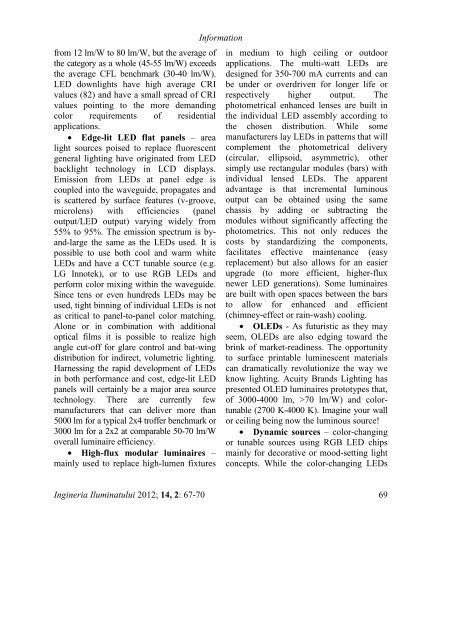Untitled - Journal of Lighting Engineering
Untitled - Journal of Lighting Engineering
Untitled - Journal of Lighting Engineering
Create successful ePaper yourself
Turn your PDF publications into a flip-book with our unique Google optimized e-Paper software.
from 12 lm/W to 80 lm/W, but the average <strong>of</strong><br />
the category as a whole (45-55 lm/W) exceeds<br />
the average CFL benchmark (30-40 lm/W).<br />
LED downlights have high average CRI<br />
values (82) and have a small spread <strong>of</strong> CRI<br />
values pointing to the more demanding<br />
color requirements <strong>of</strong> residential<br />
applications.<br />
• Edge-lit LED flat panels – area<br />
light sources poised to replace fluorescent<br />
general lighting have originated from LED<br />
backlight technology in LCD displays.<br />
Emission from LEDs at panel edge is<br />
coupled into the waveguide, propagates and<br />
is scattered by surface features (v-groove,<br />
microlens) with efficiencies (panel<br />
output/LED output) varying widely from<br />
55% to 95%. The emission spectrum is byand-large<br />
the same as the LEDs used. It is<br />
possible to use both cool and warm white<br />
LEDs and have a CCT tunable source (e.g.<br />
LG Innotek), or to use RGB LEDs and<br />
perform color mixing within the waveguide.<br />
Since tens or even hundreds LEDs may be<br />
used, tight binning <strong>of</strong> individual LEDs is not<br />
as critical to panel-to-panel color matching.<br />
Alone or in combination with additional<br />
optical films it is possible to realize high<br />
angle cut-<strong>of</strong>f for glare control and bat-wing<br />
distribution for indirect, volumetric lighting.<br />
Harnessing the rapid development <strong>of</strong> LEDs<br />
in both performance and cost, edge-lit LED<br />
panels will certainly be a major area source<br />
technology. There are currently few<br />
manufacturers that can deliver more than<br />
5000 lm for a typical 2x4 tr<strong>of</strong>fer benchmark or<br />
3000 lm for a 2x2 at comparable 50-70 lm/W<br />
overall luminaire efficiency.<br />
• High-flux modular luminaires –<br />
mainly used to replace high-lumen fixtures<br />
Information<br />
in medium to high ceiling or outdoor<br />
applications. The multi-watt LEDs are<br />
designed for 350-700 mA currents and can<br />
be under or overdriven for longer life or<br />
respectively higher output. The<br />
photometrical enhanced lenses are built in<br />
the individual LED assembly according to<br />
the chosen distribution. While some<br />
manufacturers lay LEDs in patterns that will<br />
complement the photometrical delivery<br />
(circular, ellipsoid, asymmetric), other<br />
simply use rectangular modules (bars) with<br />
individual lensed LEDs. The apparent<br />
advantage is that incremental luminous<br />
output can be obtained using the same<br />
chassis by adding or subtracting the<br />
modules without significantly affecting the<br />
photometrics. This not only reduces the<br />
costs by standardizing the components,<br />
facilitates effective maintenance (easy<br />
replacement) but also allows for an easier<br />
upgrade (to more efficient, higher-flux<br />
newer LED generations). Some luminaires<br />
are built with open spaces between the bars<br />
to allow for enhanced and efficient<br />
(chimney-effect or rain-wash) cooling.<br />
• OLEDs - As futuristic as they may<br />
seem, OLEDs are also edging toward the<br />
brink <strong>of</strong> market-readiness. The opportunity<br />
to surface printable luminescent materials<br />
can dramatically revolutionize the way we<br />
know lighting. Acuity Brands <strong>Lighting</strong> has<br />
presented OLED luminaires prototypes that,<br />
<strong>of</strong> 3000-4000 lm, >70 lm/W) and colortunable<br />
(2700 K-4000 K). Imagine your wall<br />
or ceiling being now the luminous source!<br />
• Dynamic sources – color-changing<br />
or tunable sources using RGB LED chips<br />
mainly for decorative or mood-setting light<br />
concepts. While the color-changing LEDs<br />
Ingineria Iluminatului 2012; 14, 2: 67-70 69
















